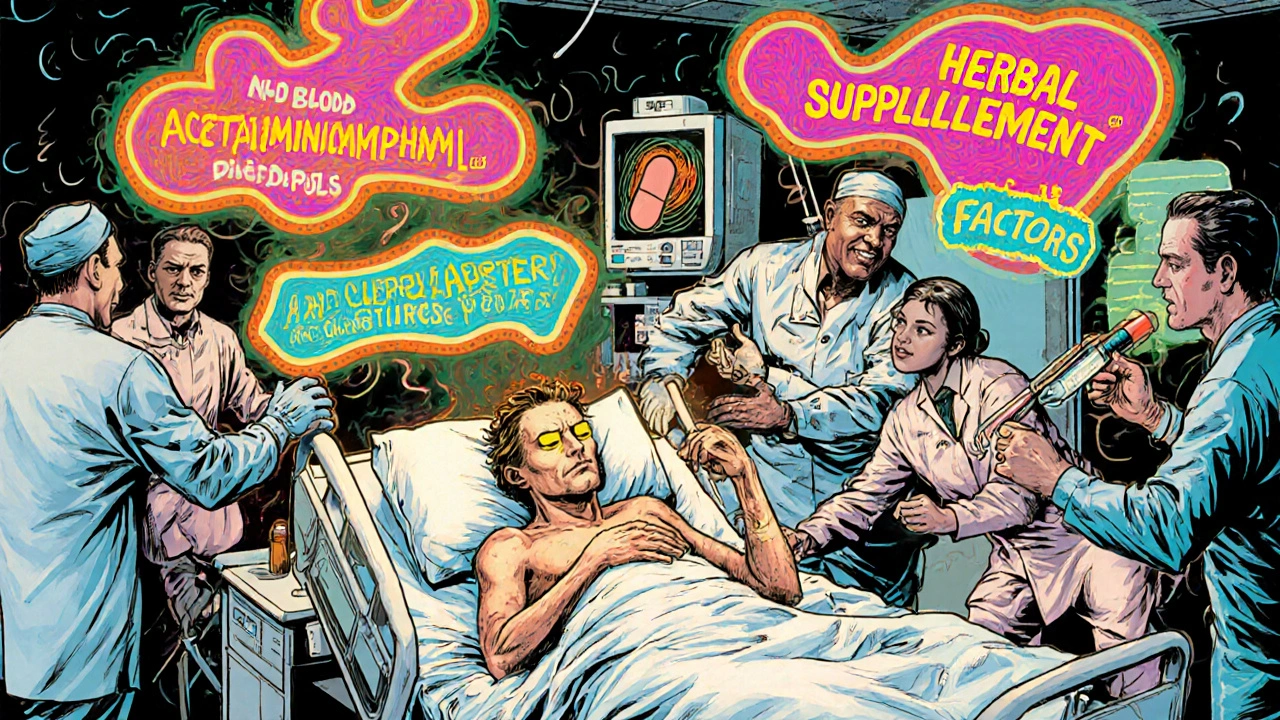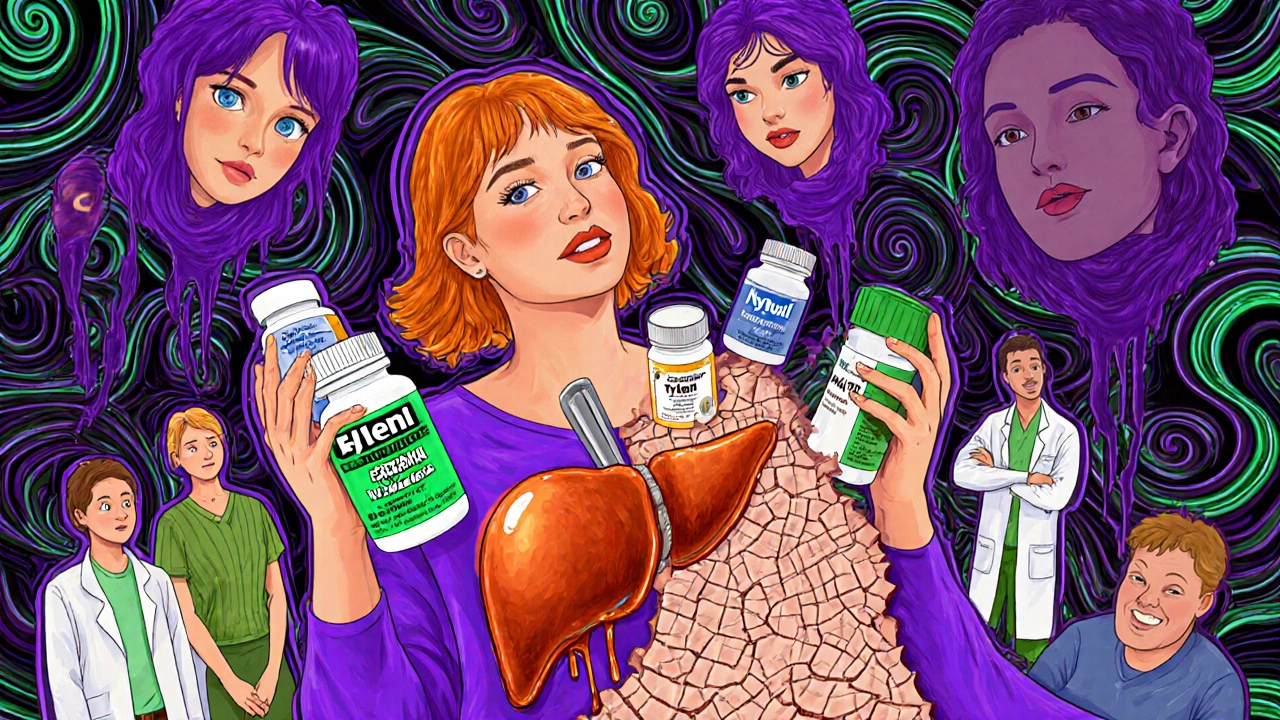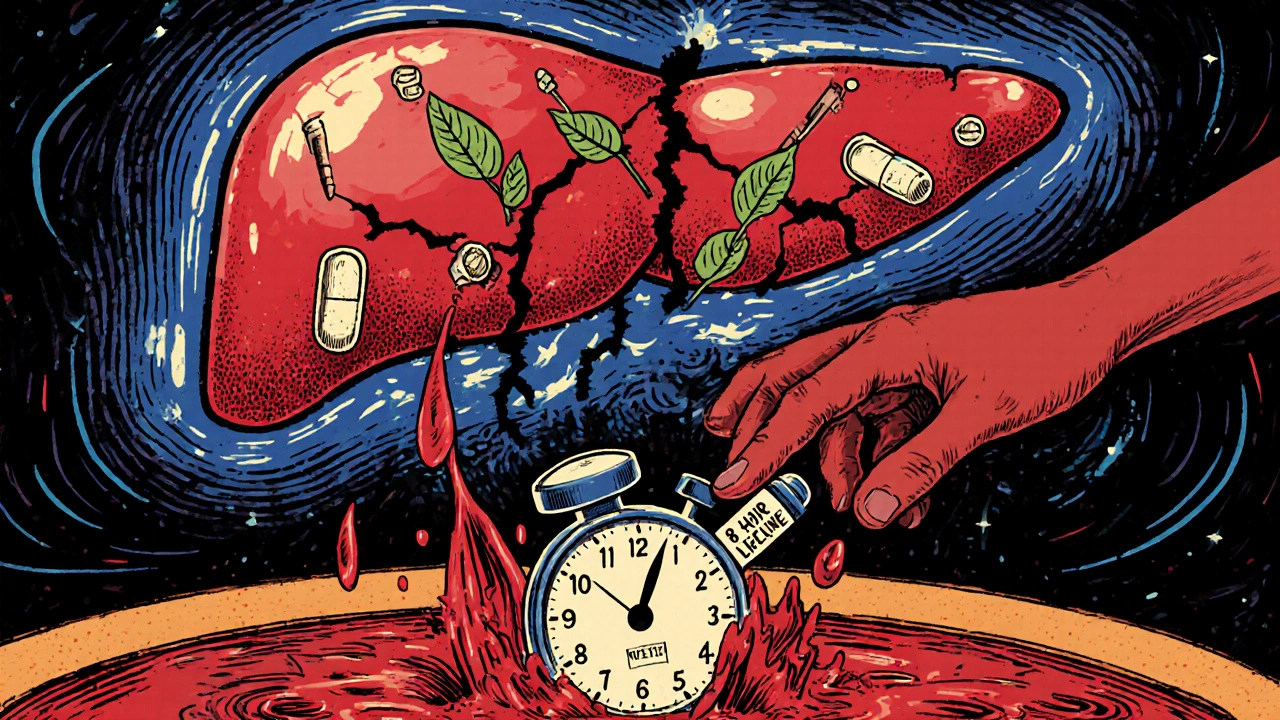
Acetaminophen Safety Calculator
Your Daily Acetaminophen Intake
This calculator helps you track all sources of acetaminophen in your medications to avoid liver damage.
- Most cold & flu medications
- Pain relievers (Tylenol, Excedrin)
- Prescription combination drugs
- Some sleep aids
Critical Safety Information
The maximum safe daily dose of acetaminophen is 4,000 mg for most adults. However:
- NAC (N-acetylcysteine) must be administered within 8 hours of overdose for 90% survival rate
- Survival drops to 30% if treatment is delayed beyond 24 hours
- INR > 6.5 and severe encephalopathy = survival < 10% without transplant
Seek medical attention immediately if: you've taken more than 4,000 mg, or if you experience nausea, yellow skin, or confusion after taking any medication.
When someone suddenly becomes confused, yellow-eyed, and vomits nonstop, most people think it’s the flu. But if they’ve taken any medication-prescription, over-the-counter, or even herbal supplements-it could be something far deadlier: fulminant hepatic failure. This isn’t a slow decline. It’s a liver that collapses in hours or days. And if you miss it, the chance of survival drops by more than half.
What Exactly Is Fulminant Hepatic Failure?
Fulminant hepatic failure (FHF), also called acute liver failure, happens when a healthy liver starts dying fast-within weeks, sometimes days. It’s not cirrhosis. It’s not chronic disease. It’s a sudden, catastrophic shutdown. Three things define it: yellow skin (jaundice), confusion or coma (hepatic encephalopathy), and blood that won’t clot (INR ≥1.5). There’s no warning. No gradual pain. Just a rapid descent into organ failure.
Most cases-nearly half-are caused by medications. That’s not just illegal drugs or overdoses. It’s the Tylenol in your medicine cabinet. The antibiotic your doctor prescribed. The green tea extract you took for weight loss. The kava supplement you tried for anxiety. All of these can trigger FHF if the body reacts badly.
Acetaminophen: The Silent Killer in Every Medicine Cabinet
Acetaminophen is responsible for 46% of all drug-induced acute liver failure in the U.S. That’s more than all other drugs combined. And here’s the scary part: most people who overdose on it didn’t mean to.
They took two extra-strength Tylenol for a headache. Then another for back pain. Then a cold medicine with acetaminophen. Then a prescription painkiller that also had acetaminophen. Before they knew it, they hit 7.5 grams in 24 hours-the threshold where liver damage becomes likely. The body doesn’t scream. It just starts dying silently.
Doctors look for two red flags: ALT levels above 1,000 IU/L (normal is under 40) and an ALT-to-AST ratio greater than 2:1. That’s the fingerprint of acetaminophen toxicity. But here’s what most ERs miss: if a patient has nausea, vomiting, and jaundice-any patient-they need an acetaminophen level checked, even if they deny taking it. Studies show 23% of people with acetaminophen-induced liver failure lie or forget they took it.
Time is everything. If you give N-acetylcysteine (NAC) within 8 hours of overdose, survival jumps to 90%. After 24 hours? It plummets to 30%. The Rumack-Matthew nomogram isn’t just a chart-it’s a lifeline. It tells you if the patient is in danger based on blood levels and time since ingestion. But it only works if someone draws the blood fast.
Other Drugs That Can Kill Your Liver-Without You Knowing
Acetaminophen is the big one, but it’s not the only one. Many other medications cause FHF in unpredictable ways. These are called idiosyncratic reactions. They don’t follow dose rules. One person takes amoxicillin-clavulanate and gets fine. Another takes the same pill and their liver shuts down in 10 days.
Antibiotics like amoxicillin-clavulanate often show up with high alkaline phosphatase and jaundice lasting longer than 18 days before confusion sets in. Antiseizure drugs like valproic acid spike ammonia levels above 150 μmol/L-before encephalopathy even shows. Herbal supplements? They’re the fastest-growing cause. Green tea extract (EGCG) at doses over 800 mg/day has caused liver failure in dozens of cases. Kava, comfrey, and chaparral are just as dangerous. And they’re sold as “natural,” so people think they’re safe.
There’s no blood test to confirm these reactions. No biomarker. No quick fix. You have to rule everything else out: viruses, autoimmune disease, alcohol, genetic disorders. That’s why doctors are taught Hy’s Law: if ALT or AST is more than 3 times the upper limit of normal and bilirubin is more than 2 times normal-you’re looking at a life-threatening drug reaction. Hospitalize. Monitor INR daily. Don’t wait.

How to Spot It Before It’s Too Late
Patients don’t walk in saying, “I think my liver is failing.” They say, “I feel nauseous.” Or, “My kid is acting weird.” Or, “My skin turned yellow last week.”
Here’s what to watch for:
- Persistent nausea-not just a stomach bug. This is the #1 symptom reported before diagnosis.
- Subtle personality changes-irritability, forgetfulness, slurred speech. Family members notice this before doctors do.
- Dark urine, pale stools, yellow eyes-classic signs, but often dismissed as “just jaundice.”
- Confusion or drowsiness-this is hepatic encephalopathy. Once it’s here, you’re in the danger zone.
- Unexplained bruising or bleeding-gums, nose, tiny red spots on skin. That’s your INR climbing.
Emergency protocols now recommend a 30-minute triage for anyone with nausea/vomiting plus jaundice. Test ALT, INR, and acetaminophen level immediately. Check mental status every hour using the West Haven Criteria. Repeat INR every 6 hours if it’s above 1.5. If INR hits 6.5 and encephalopathy is grade III or IV? That’s a transplant emergency. Survival without transplant? Less than 10%.
Why Most Cases Are Missed-and How to Fix It
Doctors miss FHF because it looks like everything else: flu, gastroenteritis, viral hepatitis, depression. A Johns Hopkins study found 17 cases where NSAID-induced liver injury was diagnosed as stomach bugs. The average delay? Over five days.
One nurse on a patient forum described a 45-year-old woman on 4 grams of acetaminophen daily for back pain. She showed up confused. ER staff ran tests. Missed the liver failure until her INR was 8.2. She nearly died.
Another case: a man took 3,000 mg of kava daily for six months. No red flags. No warning. Then he collapsed with grade IV encephalopathy. His INR was 5.8. He needed a transplant.
The fix? Three things:
- Always ask about all medications-including OTC, supplements, and herbal remedies. Don’t assume patients know what’s in their pills.
- Test acetaminophen levels in anyone with ALT >500 IU/L, no matter what they say.
- Know Hy’s Law. If bilirubin and liver enzymes are both high-treat it like FHF until proven otherwise.

The New Tools Changing Survival Rates
There’s good news. Tools are getting better. The FDA cleared a new AI system called HepaPredict in 2023. It looks at 17 clinical factors-like age, INR, ammonia, bilirubin-and predicts liver failure progression with 89% accuracy in just 24 hours. That’s a game-changer for triage.
Researchers are also testing microRNA biomarkers. miR-122, a liver-specific molecule, rises within 6 hours of acetaminophen overdose. It could become the new early warning signal-faster than ALT.
And hospitals are rolling out FHF Alert Systems. Starting in 2024, ERs in many states will be required to notify transplant centers within one hour of suspecting acute liver failure. In California, this cut transplant wait times by over 38 hours. That’s the difference between life and death.
Who’s at Risk-and What You Can Do
Women are more likely to get FHF from non-acetaminophen drugs-63% of cases are female. Especially with autoimmune reactions. Acetaminophen cases? Roughly equal between men and women.
But the biggest risk factor? Taking multiple medications with acetaminophen. You don’t need to be a drug abuser. You just need to be taking hydrocodone/acetaminophen for pain, plus NyQuil, plus Excedrin. Add them up. 4,000 mg is the max. You can hit that in two days without realizing it.
Herbal supplements? They’re not regulated. No safety testing. No dosage limits. A 2022 study found 42% of supplement-related liver failures came from green tea extract. People think “natural” means “safe.” It doesn’t.
What you can do:
- Know the ingredients in every pill you take. Read labels.
- Never exceed 4,000 mg of acetaminophen per day-even if your doctor prescribed it.
- Stop herbal supplements if you feel sick, even if it’s “just” nausea.
- If you’re on long-term antibiotics or antiseizure meds, ask your doctor about liver monitoring.
- Call the National Acute Liver Failure Foundation at 1-888-567-6253 if you suspect FHF. Their response time is under 18 minutes.
Final Warning: This Is Not a “Wait and See” Situation
Fulminant hepatic failure doesn’t wait. It doesn’t give you a second chance. If you or someone you know has jaundice, confusion, or unexplained nausea after taking any medication-get to an ER. Demand an ALT, INR, and acetaminophen level. Don’t let them dismiss it as “just a virus.”
Survival without transplant? 63% if caught early. 28% if you wait. That’s not a risk worth taking.
Can you survive fulminant hepatic failure without a liver transplant?
Yes-but only if caught early. About 63% of patients recover without transplant if treated within the first 24 to 48 hours, especially with N-acetylcysteine for acetaminophen cases. But if INR rises above 6.5 and encephalopathy is severe, survival without transplant drops below 10%. Time is the most critical factor.
Is acetaminophen the only medication that causes fulminant hepatic failure?
No. While acetaminophen causes nearly half of all cases in the U.S., many other drugs can trigger it. Antibiotics like amoxicillin-clavulanate, antiseizure medications like valproic acid, and herbal supplements like green tea extract and kava are common culprits. These reactions are unpredictable and can happen even at normal doses.
How do doctors know if a drug caused liver failure?
There’s no single test. Doctors use a process of elimination. They check for viruses, autoimmune disease, alcohol use, and genetic conditions. If a patient has elevated liver enzymes and bilirubin (Hy’s Law), and no other cause is found, the drug is suspected. A detailed medication history-including OTC and supplements-is essential. The timing of symptoms after starting the drug also helps confirm the link.
What should I do if I think I’ve taken too much acetaminophen?
Go to the ER immediately-even if you feel fine. Don’t wait for symptoms. Bring the medication bottle with you. Doctors will check your acetaminophen blood level and give you N-acetylcysteine (NAC), which can prevent liver damage if given within 8 hours. Delaying treatment reduces your chances of survival by more than half.
Are herbal supplements safer than prescription drugs for the liver?
No. Herbal and dietary supplements are not regulated for safety like prescription drugs. Many contain unknown ingredients or contaminants. Green tea extract, kava, and comfrey have caused dozens of cases of liver failure. In fact, supplement-related liver injury is the fastest-growing cause of fulminant hepatic failure in the U.S., with cases rising 42.6% in just one year.
Can I prevent medication-induced liver failure?
Yes. Always check labels for acetaminophen in all medications-cold remedies, painkillers, sleep aids. Never exceed 4,000 mg per day. Avoid herbal supplements unless recommended by a doctor who knows your full medical history. If you’re on long-term medications, ask your doctor about liver function tests. And if you develop unexplained nausea, yellow skin, or confusion after starting a new drug-seek help immediately.
8 Comments
Robert Gilmore November 17, 2025 AT 22:24
just wanted to say i took tylenol for my back pain and didn't realize it had acetaminophen in my cold med too. i checked my bottle after reading this and nearly threw up. 4,000 mg is way too easy to hit. thanks for the wake-up call.
Robert Gilmore November 18, 2025 AT 00:16
Let us not ignore the systemic failure here: the FDA's abdication of regulatory oversight over dietary supplements has created a public health catastrophe. The fact that green tea extract-untested, unregulated, and marketed as ‘natural’-is now the second-leading cause of acute liver failure in the U.S. is not an accident. It is the logical endpoint of neoliberal deregulation and consumer gullibility. The pharmaceutical industry profits from this chaos while the public pays with their livers.
Robert Gilmore November 18, 2025 AT 19:53
Okay but have you heard about the secret government program that quietly replaced all acetaminophen with a synthetic version in 2018? I know a nurse who works at a VA hospital and she says they’re seeing 3x the liver failures since then-and it’s not because people are taking more. It’s because the new formula bypasses the liver’s detox pathways and dumps toxins directly into the bloodstream. They’re calling it ‘Project Hepa-9’ and it’s being covered up because Big Pharma owns the FDA. I’ve been trying to get this on CNN but no one will touch it. My cousin died last year and they told her it was ‘idiopathic’-but I know better. The signs were there: dark urine, confusion, that metallic taste in her mouth before she collapsed. They didn’t test for NAC fast enough. They didn’t even ask about her ‘natural’ supplements. I’m not crazy. I’m just the only one paying attention.
Robert Gilmore November 19, 2025 AT 21:58
Thank you for writing this with such clarity. I work in community health and see patients every week who think herbal remedies are harmless. I now have a handout based on your points about Hy’s Law and acetaminophen stacking. I printed it in three languages. We’re saving lives just by asking, ‘What else are you taking?’
Robert Gilmore November 20, 2025 AT 16:04
This should be required reading for every high school health class.
Robert Gilmore November 21, 2025 AT 23:18
It is imperative to note that the Rumack-Matthew nomogram remains the gold standard for acetaminophen toxicity risk stratification; however, its utility is contingent upon timely serum level acquisition. Delays beyond the 8-hour therapeutic window significantly diminish the efficacy of N-acetylcysteine, thereby increasing mortality. Furthermore, the emergence of miR-122 as a potential early biomarker may revolutionize preclinical detection, though it remains investigational and not yet validated for routine clinical deployment.
Robert Gilmore November 23, 2025 AT 14:16
It is regrettable that such a critical medical topic is reduced to a viral social media post riddled with hyperbole and anecdotal evidence. While the core message regarding acetaminophen toxicity is valid, the sensationalized framing-‘silent killer,’ ‘natural means safe’-undermines scientific literacy. A properly peer-reviewed article would have contextualized incidence rates, clarified population attributable fractions, and distinguished between idiosyncratic reactions and dose-dependent toxicity. As it stands, this reads like a marketing pamphlet for transplant centers.
Robert Gilmore November 24, 2025 AT 00:50
Y’ALL. I just checked my medicine cabinet. 🤯 I had Tylenol, Advil Cold & Sinus, and a ‘natural energy booster’ with green tea extract. All in the same drawer. I just threw them all out. 💔 I’m not dying for a headache. I’m sending this to my mom, my brother, my yoga teacher, and my dog walker. 🙏❤️ #LiverAwareness #DontBeThatPerson